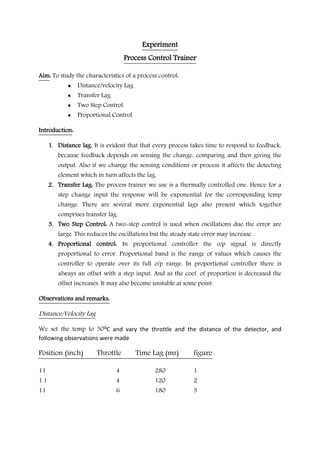
EEP301: Process control trainer
- 1. Experiment Process Control Trainer Aim: To study the characteristics of a process control: Distance/velocity Lag Transfer Lag Two Step Control Proportional Control Introduction: 1. Distance lag: It is evident that that every process takes time to respond to feedback, because feedback depends on sensing the change, comparing and then giving the output. Also if we change the sensing conditions or process it affects the detecting element which in turn affects the lag. 2. Transfer Lag: The process trainer we use is a thermally controlled one. Hence for a step change input the response will be exponential for the corresponding temp change. There are several more exponential lags also present which together comprises transfer lag. 3. Two Step Control: A two-step control is used when oscillations due the error are large. This reduces the oscillations but the steady state error may increase. 4. Proportional control: In proportional controller the o/p signal is directly proportional to error. Proportional band is the range of values which causes the controller to operate over its full o/p range. In proportional controller there is always an offset with a step input. And as the coef. of proportion is decreased the offset increases. It may also become unstable at some point. Observations and remarks: Distance/Velocity Lag We set the temp to 30⁰C and vary the throttle and the distance of the detector, and following observations were made Position (inch) Throttle Time Lag (ms) figure 11 4 280 1 1.1 4 120 2 11 6 180 3
- 2. Conclusion: The detector element is able to detect and correct the process temperature efficiently when it is close to the heating element .This is because the changes in process sensed by detector in less time and also error from surrounding is reduced. On increasing the throttle rate we are increase air flow rate which in turn reduces time spent in sensing as now the temp is changed more swiftly due to the fast inflow. Transfer Lag: The set value is 30⁰C; we vary the detector position and throttle control. And following observations were made Position (inch) Throttle Time Lag (ms) figure 11 4 880 4 1.1 4 440 5 11 6 520 6 The velocity lag for triangular waveform gave similar observation (qualitatively) as the square wave. Conclusion: The difference in velocity lag for different case of triangular wave has same reason as with the square wave i.e. transfer lag has same characteristics as of distance lag. The change of detector position/throttle speeds up the response i.e. if the error is made to be sensed earlier; the response too is earlier either by keeping the detector near or by making the response reaches earlier. Two Step Control: The idea of two step control is to have a fixed error correcting values ± if the signal exceeds or falls below the certain value, So as to reduce the oscillations. Also if we use overlap, then the frequency is further reduced but the error may increase. On increasing the overlap the frequency at which correcting unit is required operate decrease. This is very well shown by the figures below: Heater Power Set value figure 1 40 7 0.9 40 8 0.8 40 9
- 3. 0.6 40 10 1 30 11 1 20 12 Conclusion: In two step control the controller output signal is changes sign whenever the measured value of temperature signal crosses the overlap. On increasing the overlap the time of change of controller signal increases as more time is required to cross the overlap. Also the error will increase and signal may settle anywhere between the overlap ranges. Proportional Control: With 40⁰C as the set value and we vary the proportional band, which in-turn is changing, the coef. of proportion. On decreasing the proportional band the difference between set value and measured value decreases and become unstable. This is shown by the following observations: Proportional Band offset 200 -5 140 -4 100 -3 50 -2 30 -1.5 5 -0.5 The graph comes out as follows: Note: The graph is extrapolated using straight lines.
- 4. Conclusion: On increasing the proportional band the difference between set value and measured value increases and become unstable. This is because the steady state error is of the form 1/(k+1), which is inversely proportional to the proportional band. The offset is indicative of the steady state error. Also if proportional band is decreased more the system will become unstable as the ‘k’ will increase and hence the error signal that is fed-back will rise out of bounds.
